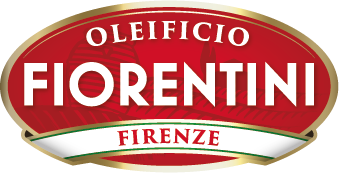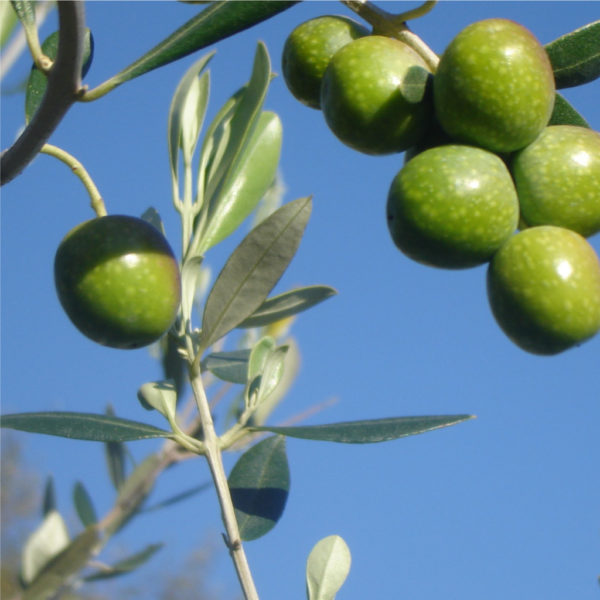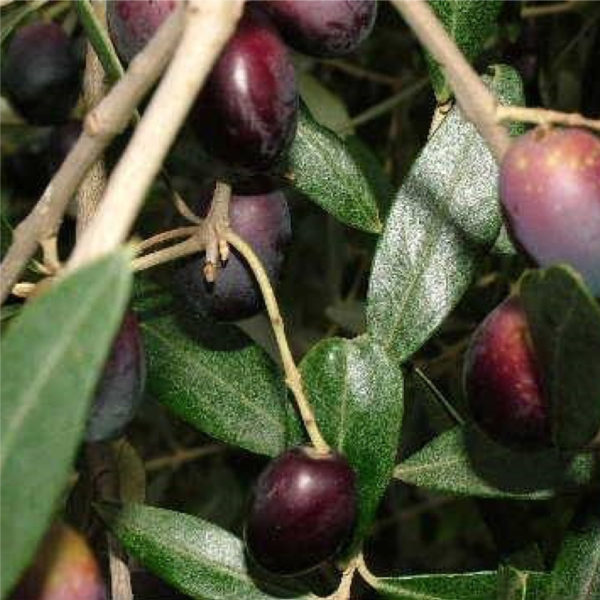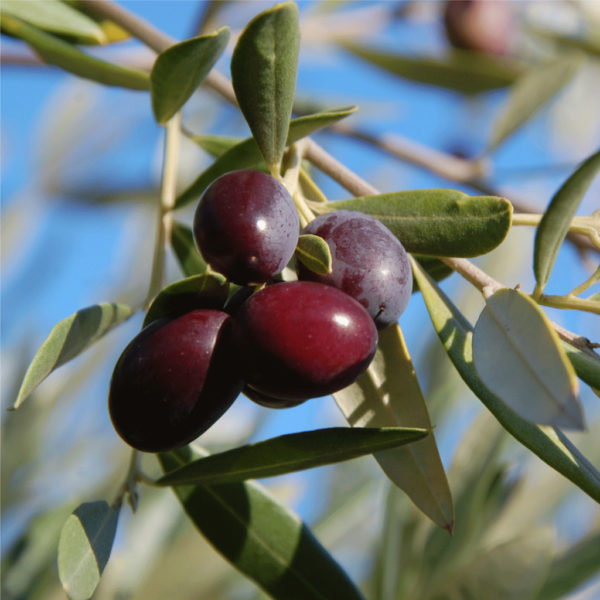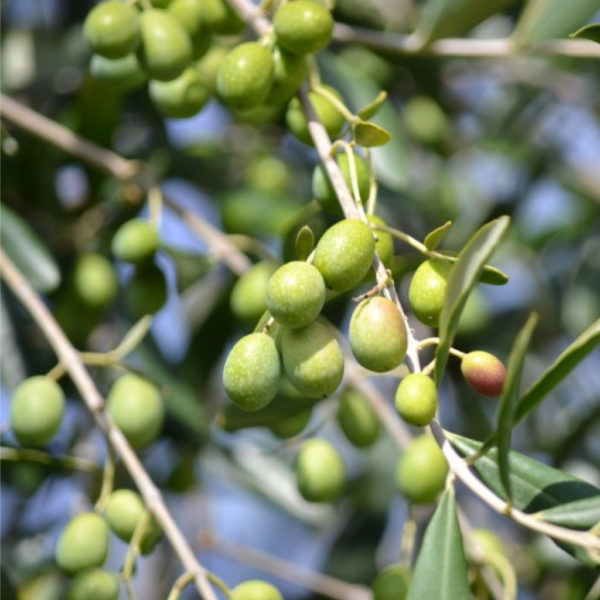THE OLIVE
The olive is a fruit with a thin skin, fleshy pulp and woody stone, the reproduction of which is assisted by the animals that eat and digest the fruit and disseminate the stones.
The hundreds of varieties of olives in existence are distinguished, first and foremost, by their shape and size, whilst the ratio between the stone and pulp determines the quantity of oil contained in the fruit, which varies from 18 to 27%. The productivity of the plant depends on many factors connected to the climate and cultivation techniques used which, by directly influencing the productivity of the plants, determine the biannual rhythm of full production. The drupe of the olive consists of the skin (1.5-3.5%) (epicarp), the pulp (75-85%) (mesocarp), and the stone (2-4%) (endocarp)..
Each drupe contains just one bony seed, composed of an external husk, called the endosperm or tegument, and an internal part called the episperm. Enclosed within this is the embryo which contains a small part of the oil that is difficult to extract.
The olives reach maturity in different periods of the year according to the variety: October for the early olives, whilst the late varieties go on until December or January.
Upon ripening, the olives increase their percentage of lipids and reduce their water content; therefore, if the drupes are to be pressed for oil, the moment at which they are harvested is crucial for obtaining a good oil.
CLASSIFICATION OF OILS
Since the oil forms spontaneously inside the olive, no sophisticated systems are required in order to extract it. Chemically speaking, the juice obtained from pressing consists of two basic components: the saponifiable part (around 98%) and the unsaponifiable part (around 2%). This valuable condiment is preserved, inside the olive, in minuscule sacs covered by a thin membrane of antioxidants, substances that prevent the deterioration of the chlorophyll, aromas, vitamins, mineral salts, tannins and the many other components that are good for our health (unsaponifiable part). The saponifiable part is the fatty component consisting of glycerides, monounsaturated ,polyunsaturated and saturated acids. In this part of the olive, the most important substances are the unsaturated fatty acids that have the merit of not raising cholesterol.
The unsaponifiable part (sterols, vitamins, pigments, polyphenols, hydrocarbons, etc.), although present in minimum quantities, is the part that fundamentally influences the nutritional, organoleptic quality and the product classification. In order to maintain high levels of this important part and increase the quality, it is necessary to adopt particular and strict measures during harvesting, the processing of the olives and the preservation of the oil.
At the end of its ripening cycle, an olive is composed on average of:
. around 45-50% water (according to the climatic trend)
. 45-50% oil (according to the cultivar and place of cultivation)
. 20-29% other (carbohydrates, cellulose, ash…)
1
VIRGIN
OLIVE OIL
Oils obtained solely through mechanical or other physical processes that have not been subjected to any treatment other than washing, decanting, centrifugation and filtering, excluding oils obtained using solvents or adjuvants with chemical or biochemical actions, or re-esterification processes and any mixing with other types of oils, are divided into Extra Virgin Olive Oil, Virgin Olive Oil and Lampante Oil according to the characteristics of acidity.
2
REFINED
OLIVE OIL
Olive oil obtained from refined virgin olive oil with a content of free acidity, expressed in oleic acid, of no more than 0.3 g per 100 g which possesses the other characteristics that comply with those required for that category.
3
OLIVE OIL
Olive oil obtained from a cut of refined olive oil with virgin olive oil other than lampante oil, with a content of free acidity, expressed in oleic acid, of no more than 1 g per 100 g and the other characteristics that comply with those required for that category.
4
RAW OLIVE -
POMACE OIL
Oil obtained from olive-pomace through treatment with solvents or through physical processes, or oil corresponding to lampante olive oil, except for some specific characteristics, excluding oil obtained through re-esterification and mixtures with other types of oils, and which possesses the other characteristics that comply with those required for this category.
5
REFINED OLIVE -
POMACE OIL
Oil obtained from the refinement of raw olive-pomace oil with a content of free acidity, expressed in oleic acid, of no more than 0.3 g per 100 g and which possesses the other characteristics that comply with those required for this category.
6
OLIVE -
POMACE OIL
Oil obtained from a cut of refined olive-pomace oil and virgin olive oil other than lampante oil, with a content of free acidity, expressed in oleic acid, of no more than 1 g per 100 g and which possesses the other characteristics that comply with those required for this category.
TASTING GUIDE
How to taste olive oil.

OLIVE OIL AND HEALTH
The symbol and one of the key components of the Mediterranean diet, olive oil is also a synonym for flavor and health. In addition to being an excellent condiment that enhances the flavors of foods, it is indispensable for keeping the body healthy and efficient at any age. Rich in antioxidants and healthful substances, it has high nutritional value and helps prevent many diseases, thus increasing life expectancy. It helps the intestines absorb vitamins, facilitates digestion and regulates the amount of cholesterol in the blood. It has been scientifically proven that a diet rich in olive oil reduces the risk of cardiovascular diseases, atherosclerosis and cancer.

OLIVE OIL IS GOOD AND IT’S GOOD FOR YOU
All the health-giving properties of olive oil are particularly strong in extra virgin – and thus in the PDO/PGI oils, the finest types of olive oil. It is useful for people of all ages, recommended for infants and children because it is easy to digest and helps growth. It helps keep you young. It is recommended for older people, once again because it is easy to digest and helps the body absorb vitamins and minerals, stimulating bone mineralization and preventing calcium loss. Thanks to its high nutritional values it is ideal for athletes because of its high energy content.
